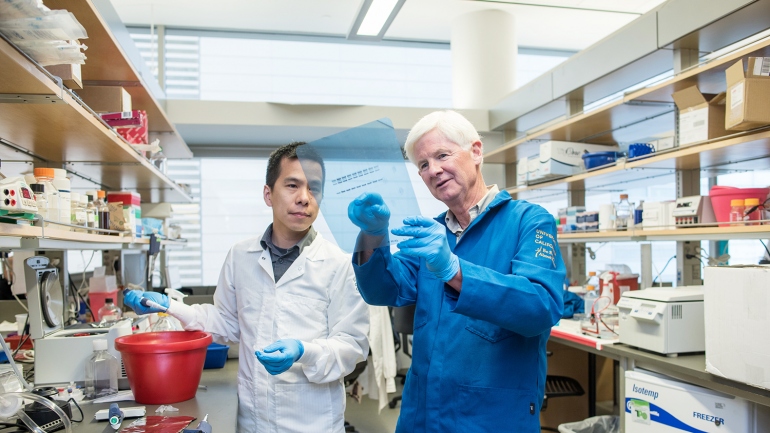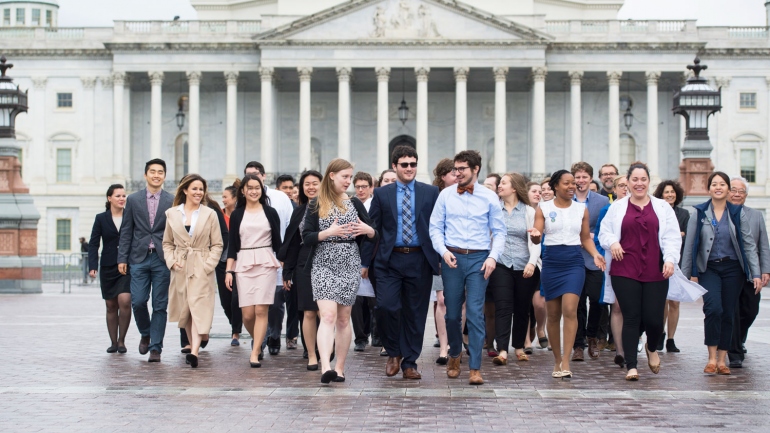Congress Supports the NIH, But Questions Remain About Key Federal Funding Stream
Critical Facility and Administrative Reimbursements Protected by Lawmakers
Both the U.S. House of Representatives and the Senate have unequivocally rejected a Trump Administration proposal to cut the National Institutes of Health (NIH) budget by $7.7 billion, or by 22 percent, in fiscal year 2018.
Despite strong bipartisan support for the NIH, questions remain in Congress and the Administration about the importance of a key federal funding stream that supports biomedical research.
The President’s budget called for cuts in two types of funding, both of which are crucial for U.S. research institutions, including UC San Francisco.
The first type of funding the Administration proposed cutting was the type that goes directly to researchers in the form of grants.
The second, less discussed than cuts in research grants – but still critically important – was a proposal to slash by two-thirds the payments the NIH distributes to cover the overhead costs of the research supported by those grants.
What Are F&A Costs?
F&A costs, or shared expenses, are costs incurred in the conduct of externally sponsored research that are shared across a large number of projects as well as other functions of the University. They include:
- Grant administrative services
- Lab operations and maintenance
- Depreciation and debt services taken on for new construction to provide researchers with modern facilities
Source: University of California
This funding for facilities & administrative (F&A) costs, or “indirect” support, is intended to reimburse universities for the additional expenses that support research – such as the cost of constructing, maintaining and operating research space as well as the staff needed to support the research.
“F&A funding is essential to our research enterprise,” said Kevin M. Shannon, MD, the Roma and Marvin Auerback Distinguished Professorship in Pediatric Molecular Oncology, who has conducted groundbreaking leukemia research with NIH funding. “Without it, UCSF would be strapped to provide the support necessary for our faculty, trainees, and students to conduct world-class biomedical research.”
At UCSF, the top public recipient of NIH funding, the President’s proposal would have had far-reaching impacts. In 2016, the University received $624 million in NIH funding, both directly and as part of projects led by other institutions.
“More than 75 percent of UCSF’s research is conducted in partnership with the federal government,” said Daniel Lowenstein, MD, executive vice chancellor and provost. “Significant cuts to indirect funding would have an impact on everything we do, including education, patient care and fulfilling our mission to the public. As an academic medical center, research is at the heart of all these endeavors.”
The House and Senate recently introduced legislation that significantly increases the budget for the NIH and prohibits the Administration from capping F&A reimbursements.
“Congress has made it clear that supporting biomedical research and innovation is a bipartisan priority, and they would not reverse the progress that has been made over the last several years by enacting the devastating cuts proposed by the President,” said Keith Yamamoto, PhD, vice chancellor for Science Policy and Strategy.

While congressional action sent a strong message to the Administration that Congress will not entertain proposals to gut biomedical research funding, the discussion about F&A rates is expected to continue in Washington.
“It became clear in our conversations with Members of Congress that even some of our greatest NIH advocates do not fully understand that a cut to F&A cost reimbursement is actually a cut to NIH research,” said Yamamoto. “We in the academic community have work to do to convey the importance of this funding to scientific discovery and progress.”
Of UCSF’s total NIH funding, about $465 million pays for the direct cost of doing research, such as salaries, equipment and supplies. The other $159 million goes to administrative functions and to help cover the cost of new and existing buildings with specialized and expensive research space and, increasingly, huge pieces of fixed equipment that can cost millions of dollars to buy and maintain, but that many researchers are able to share to do their work.
“The buildings in which our research is conducted, many core services, the laboratory safety programs, the IT infrastructure needed to keep digital information secure – these are all part of the cost of doing research,” Lowenstein said. “It is incorrect to say these are only ‘indirectly’ part of research, since without the proper infrastructure in place, the research could not occur.”

Become a UCSF Advocate
Preserve Medicaid. Stand up for DACA. Protect research funding. Join UCSF in speaking out to shape policy issues that impact the future of health.
The Administration’s proposal to cap F&A funding was a significant departure from how research has been funded for roughly 70 years.
For decades, the federal government has partnered with academia to conduct life-saving research – and at a much lower cost than the government would incur if it were to do the research on its own. This compact between the government and academia has always acknowledged that there is a real cost to support the environment in which research occurs, and since 1947 the government has been providing F&A funding along with its grants.
“The long history of the federal government supporting costs associated with biomedical research highlights the importance of this type of funding,” said Chancellor Sam Hawgood, MBBS. “There is a misconception that universities can somehow absorb these costs, or look to the state for additional funds. If a proposal like this is ever implemented, public universities will have to make hard decisions about the research they conduct on behalf of the federal government.”
For more campus news and resources, visit Pulse of UCSF.